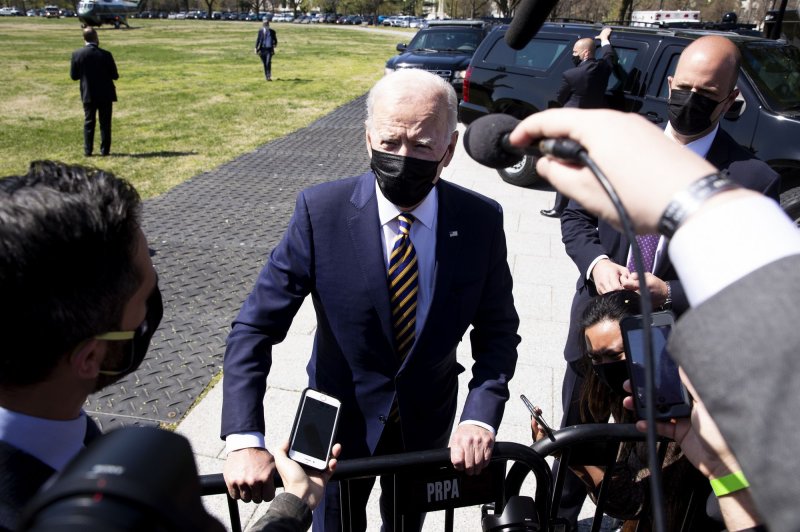President Joe Biden's administration is preparing a $1.9 trillion infrastructure package paid for by increasing corporate taxes from 21% to 28% and on households making more than $400,000 a year. Photo by Michael Reynolds/UPI |
License Photo
President Joe Biden was dealt the worst hand of any newly elected president since Abraham Lincoln and a nation as polarized perhaps as it was in 1861.
This a 51% nation, intractably split, and both parties are at each other's throats. With no Republican votes, the Democrats muscled a $2.2 trillion American Relief Package through Congress. Now the Biden team is preparing a $1.9 trillion infrastructure package paid for by increasing corporate taxes from 21% to 28% and on households making more than $400,000 a year.
But not only tax increases face harsh blowback. Many of the specifics will be seen as a government-driven revolution as sweeping as Franklin Delano Roosevelt's New Deal.
Most importantly, how this infrastructure plan will be executed and rigorous oversight assured is far from clear. If past examples of Solyndra and other government-backed technology companies that failed are not taken seriously and corrected, waste, fraud and abuse will run rampant. With $2.2 trillion at play, this will be a huge amount of money put at risk.
Given that the Biden infrastructure plan faces powerful opposition, what might be an alternative to address the dilemmas of tax increases that threaten economic growth and additions to the massive debt that could approach $30 trillion in the not-too-distant future? The concept of applying a public-private infrastructure partnership can benefit from the wisdom of President Dwight Eisenhower. When confronting a difficult problem, Ike would enlarge the problem to solve it.
It is painfully obvious that obsolete American infrastructure from the power grid to highways, bridges, air and sea ports, education and the Internet must be repaired and modernized for the 21st century. Sadly, the national track record in fixing its infrastructure has been consistent: Complain and take no real action.
Using Ike's advice, traditional public-private partnerships would be expanded beyond infrastructure into a broader national investment fund. Biomedicine, renewable energy, larger capacity batteries, CO2 sequestration, artificial intelligence, quantum computing, cyber, 3D printing, advanced materials and other technologies are crucial to rejuvenating infrastructure and the economy and creating employment. Without exploiting these technologies, modernizing infrastructure is an oxymoron and cannot be done.
The National Investment Fund would be a public-private partnership seeded with about $1 trillion in federal money (and hence needing fewer tax increases) and at least an equal amount from the private sector through the issuance of 30-year bonds incentivized with 2% to 3% interest rates above prime guaranteed by the government.
The fund would be off-budget and repaid by user fees, tolls and returns on investment. For those who doubt government can make as oppose to print money, the Troubled Asset Relief Program of about $800 billion put in place after the financial crisis of 2008 returned many billions to the Treasury in profits and interest.
The program should be named the 1923 Fund after the greatest economic boom in American history that began in 1923 following the 1918-20 Spanish flu pandemic. Hopefully, sufficient guardrails are in place to prevent the recurrence of the 1929 financial crash that ended the "Roaring '20s."
Electrification of the country and automobile production empowered that boom, accelerating productivity and creating massive demand for steel, rubber, gasoline, highways, bridges, restaurants, hotels and other supporting infrastructure. Today's parallels are universal access to 5G and broadband, as well as the technologies noted above.
John Maynard Keynes observed that recessions and economic downturns ultimately were resolved by technology. Depending on how one counts, the United States is in the midst of a fourth or fifth technical revolution. The industrial, nuclear and information revolutions were the first three. The genome biomed revolution was the fourth. Now with quantum computing and other AI technologies, a fifth revolution is upon us.
A 1923 National Investment Fund could concentrate on infrastructure and technology and redress much of the major opposition and obstacles to the Biden plan. Clearly, a mechanism to execute and oversee the investment is vital. None so far has been described in the current program. And here the major threat is politicization of any organization to exercise and oversee the proper use of these funds that would destroy any chance of success.
If this fund is properly enacted and executed, not all problems will be solved. But tens of millions of jobs and high rates of economic growth will be created and infrastructure modernized. The ultimate test will be overcoming a dangerously divided and polarized nation in which one aim of both parties is to ensure the other fails.
Harlan Ullman is senior adviser at the Atlantic Council in Washington, D.C., and author of the upcoming book, "The Fifth Horseman and the New MAD: The Tragic History of How Massive Attacks of Disruption Are Endangering, Infecting, Engulfing and Disuniting a 51% Nation."















